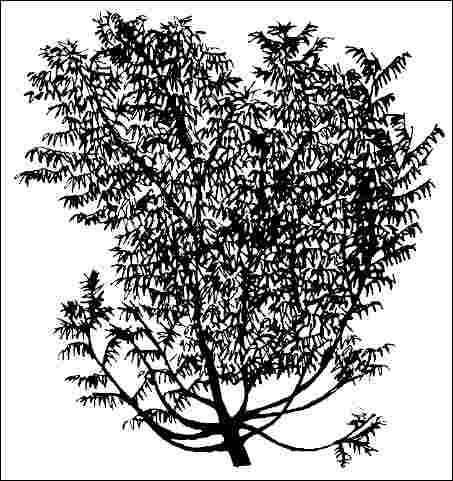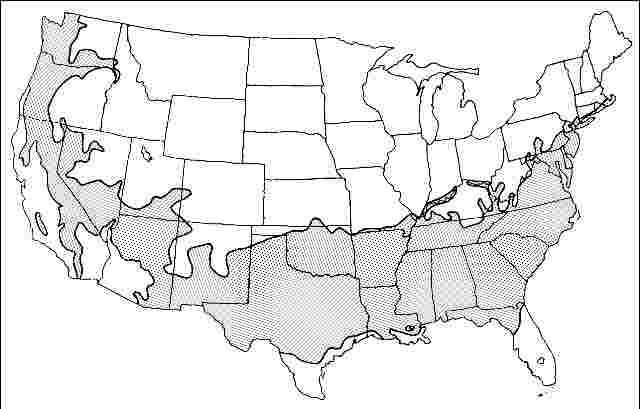Introduction
Prairie flameleaf sumac forms a loose, spreading small tree, reaching up to 25 feet in height. Most specimens only grow to about 12 to 18 feet tall. The shiny, pinnately compound leaves change to a brilliant orange, red, or yellow in the fall before dropping. The yellowish-white, summertime flowers appear in 6- to 10-inch-long and wide, terminal panicles and are quite showy. The hairy fruits which follow are orange/red and mature in October.

Credit: UF/IFAS
General Information
Scientific name: Rhus lanceolata
Pronunciation: roose lan-see-oh-LAY-tuh
Common name(s): Texan sumac, prairie flameleaf sumac, prairie sumac
Family: Anacardiaceae
USDA hardiness zones: 6B through 8B (Figure 2)
Origin: native to North America
Invasive potential: not assessed/incomplete assessment
Uses: reclamation; highway median; container or planter; specimen

Credit: UF/IFAS
Description
Height: 12 to 20 feet
Spread: 15 to 20 feet
Crown uniformity: irregular
Crown shape: upright/erect, oval
Crown density: moderate
Growth rate: moderate
Texture: medium
Foliage
Leaf arrangement: alternate
Leaf type: odd-pinnately compound
Leaf margin: entire
Leaf shape: ovate, oblong, lanceolate
Leaf venation: pinnate
Leaf type and persistence: deciduous
Leaf blade length: 2 to 4 inches
Leaf color: green
Fall color: orange, red
Fall characteristic: showy
Flower
Flower color: white/cream/gray
Flower characteristics: showy
Fruit
Fruit shape: round
Fruit length: less than 0.5 inch
Fruit covering: fleshy
Fruit color: red
Fruit characteristics: attracts birds; showy; fruit/leaves not a litter problem
Trunk and Branches
Trunk/bark/branches: branches droop; not showy; typically multi-trunked; thorns
Pruning requirement: needed for strong structure
Breakage: resistant
Current year twig color: brown, reddish
Current year twig thickness: medium, thick
Wood specific gravity: unknown
Culture
Light requirement: full sun, partial sun, or partial shade
Soil tolerances: clay; sand; loam; alkaline; acidic; well-drained
Drought tolerance: high
Aerosol salt tolerance: unknown
Other
Roots: not a problem
Winter interest: no
Outstanding tree: yes
Ozone sensitivity: unknown
Verticillium wilt susceptibility: susceptible
Pest resistance: free of serious pests and diseases
Use and Management
Training is required to make this large shrub into a tree. Begin by staking the main stem in the upright position for a year or two and develop branches beginning at two to four feet from the ground. Space branches 8 to 12 inches apart and be sure than they form a wide angle with the trunk. This will help ensure that they are well attached to the tree. Occasional pinching or heading back of the terminal shoot and branches will increase branching. Suckers from the base of the trunk may have to be removed periodically to maintain a neat appearance.
Place Texan sumac in a prominent location in the landscape in the full sun. It is a nice tree for planting in a low ground cover to display the interesting trunk and branch arrangement. The fine-textured foliage, showy flower display and bright fall color combine to make this small tree suitable for increased usage in southern landscapes.
Sumac should be grown in full sun on well-drained soil, acid or alkaline. This tree is often found on limestone or clay soils with a high soil pH in its native habitat, but it also grows on acidic soil. It would be well suited for inclusion in a low maintenance landscape where plants receive little if any irrigation. Too much irrigation and fertilization can lead to plant decline.
Propagation is by seed.
Pests and Diseases
There are no serious pests or diseases as long as plants are not overwatered.